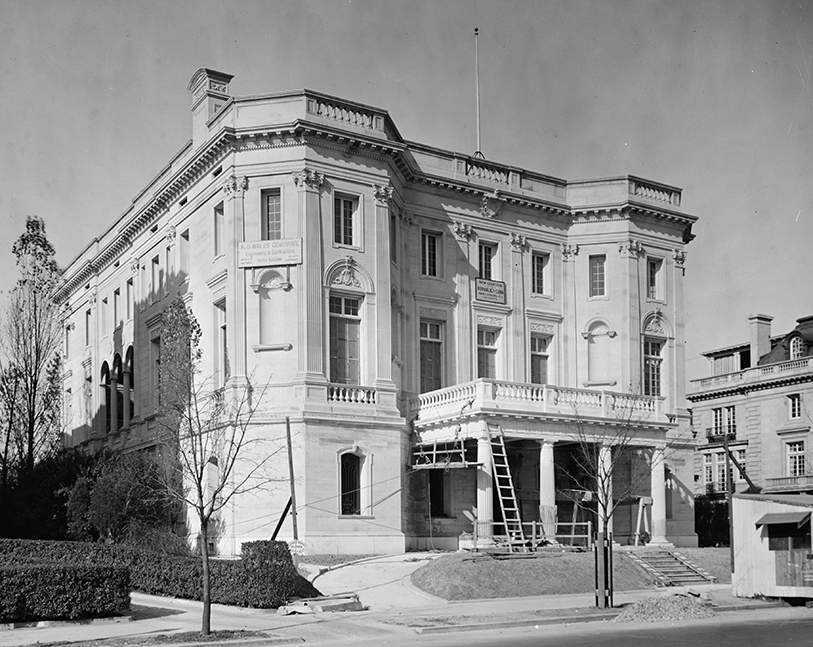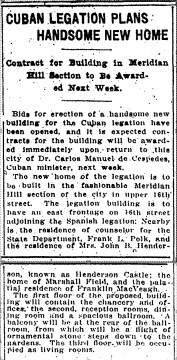The soon-to-be official Cuban Embassy in the United States has a nearly 100-year history in Washington D.C.
Slight right and left for before and after


The three-story structure was built in 1917 by the Cuban government and will reopen on July 20 — the same day that the U.S. Embassy in Havana will open — marking a major step in restoring ties between the two nations.
Historic photographs and news reports at the time show that the brick and stone structure at 2630 16th Street NW in Washington D.C. is virtually unchanged since then Cuban Minister Dr. Carlos Manuel de Cespedes commissioned the building in Nov. 1916. A Washington Evening Star article described the building as “handsome” and build on the “fashionable Meridian Hill section of the city”.

Nov. 18, 1916 article in the Washington Evening Star.
The embassy’s prominent neighbors included State Department counselor Frank L. Polk, Mary Foote Henderson (of Henderson Castle), and former Treasury Secretary Franklin MacVeagh.
The 1916 plans for the first floor included the embassy’s offices. The second floor was for reception rooms, a dining room, and a “spacious ballroom” with a balcony and a “flight of ornamental stone steps down to the gardens.” The third floor were the ambassador’s living quarters.

March 31, 1917, Washington Evening Star classified ad.
Residents, employees, and visitors to the embassy included de Cespedes, who would later briefly become President of Cuba in 1933, as well as Secretary of State Charles Evans Hughes in 1924, President Calvin Coolidge in 1927, Cuban dictator Fulgencio Batista in 1938, and Fidel Castro in 1959.
Castro traveled to the United States in April 1959 and had lunch at a hotel with then acting Secretary of State Christian Herter where he told him the people of the United States would one day “recognize the whole truth of the revolutionary struggle” and that he saw no reason why relations between Cuba and the United States should not be “the best”, according to a Washington Post report.

Fidel Castro holds Sherry Robin Hayes while making a tour of Meridian Hill Park near dusk on April 16, 1959. (Photo by Lee Hayes via Old Time D.C. Facebook group.)
Washington Post reporter Phil Casey interviewed Castro “at the foot of the long, marble staircase in the red-carpeted Embassy foyer, just as the weary Castro was hoping to escape to his room for a brief rest.”
The Post said when he first arrived, an embassy attache suggested that Castro go up to building’s balcony to wave at the nearly 150 people who had gathered outside to see him.
“I’m no man on a balcony,” Castro snorted and took off, dodging nimbly through the traffic to meet the people, The Post reported.
“Returning to the embassy, where a crowds of about 200 all cleared by security guards awaited him, he went to his third-floor room, flopped on a bed fully clothed and announced ‘I’m tired. Tired.’,” the Post article reads.
It was during this visit that he traveled to Meridian Hill Park and visited with locals, including a young Sherry Robin Hayes (see left photo).
The United States and Cuba severed ties in 1961, and Cuba asked Czechoslovakia to occupy the mansion in Cuba’s absence. It was not until Sept. 1, 1977 that the embassy became the Cuban Interests Section under Czechoslovakian Embassy, and later the Cuban Interests Section under the Swiss Embassy.
In May 1979 the Cuban exile paramilitary group Omega 7 claimed responsibility for a bomb that was thrown into the backyard of the embassy. Windows were shattered, but no one was injured.
Last month, following the reopening of ties between the United States and Cuba, staff installed a flagpole in front of the mansion. On July 20th, the Cuban flag will be hung on that flagpole where it will fly above the embassy for the first time in 54 years.
 CGTN America
CGTN America

